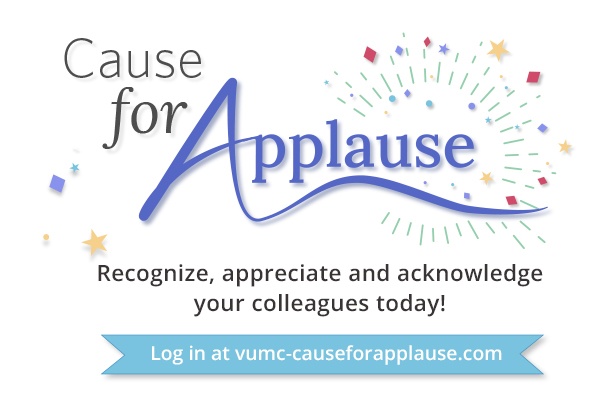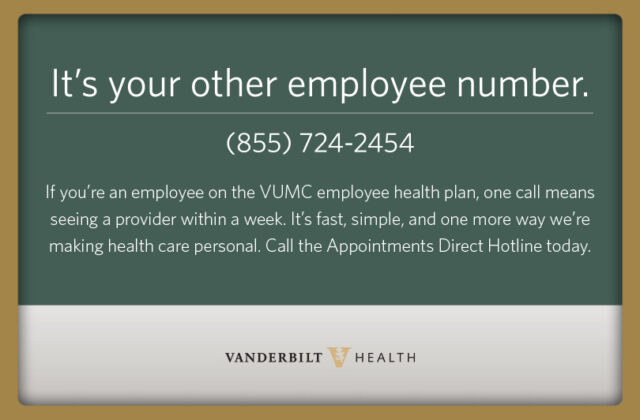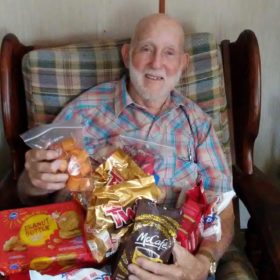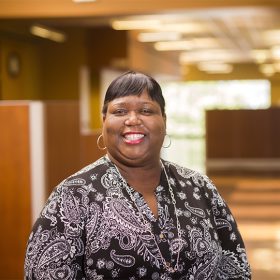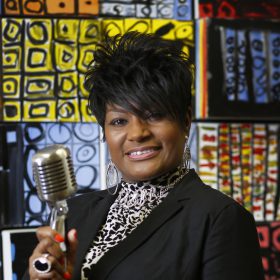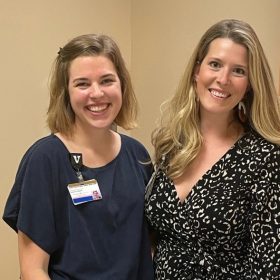Katrina Robertson went from death’s door to a full life. Her story is one of thousands from the first 25 years of the Vanderbilt Comprehensive Care Clinic
The VCCC opened its doors 25 years ago when AIDS was fatal and hope was rare. Today the clinic serves thousands of patients and is an international model in the treatment of people with HIV.
February 6, 2019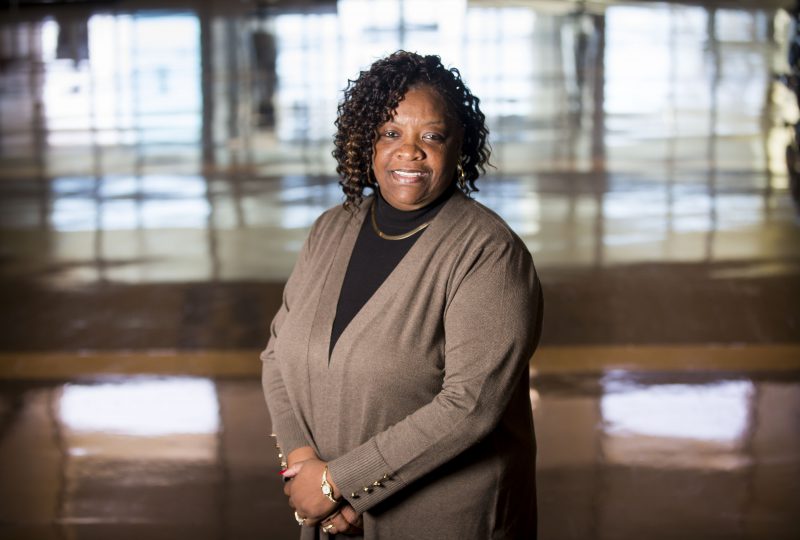
Katrina Robertson has been a patient of the Vanderbilt Comprehensive Care Clinic for almost all of its 25 years. Photo by Susan Urmy.
When Katrina Robertson heard the news, she knew what it meant.
“I knew I was going to die,” she said.
It was 1995, and her doctor had just told her she had tested positive for HIV, the virus that causes AIDS. At that time, there was no treatment, and the disease was almost always fatal.
Robertson says her life at that time was very hard for reasons even beyond her illness.
“I have had a long battle with a horrible crack addiction,” she said matter-of-factly. “I was on the street, I was trafficked, selling my body. I was in and out of jail.
“I had been dating a guy who I found out had HIV after he passed away.”
There was a tremendous stigma and much fear associated with AIDS, and patients were often estranged from their families, their friends, their churches, their communities. Since many of the patients were gay men who had not come out of the closet before diagnosis, there was an extra measure of stigma for some. The VCCC became a safe place for the dying and the ostracized — for some, the only safe place they knew.
It was at this point, following her HIV diagnosis, that Robertson was referred to the Comprehensive Care Center, which had been founded the previous year. (Since 2010, it has been known as the Vanderbilt Comprehensive Care Clinic (VCCC), which, for simplicity, is how it will be referred to here).
“I remember walking in and there was Quentella [Carpenter] at the front desk. She invited me in. She didn’t ridicule me. I cried and she consoled me.”
And Robertson has been a patient at the VCCC since. Her experience was a common one in those early days of the center.
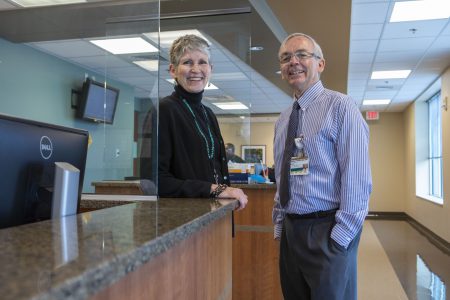
Bev Byram and Stephen Raffanti worked together for most of the 25-year history of the VCCC. Photo by Anne Rayner
The VCCC began 25 years ago as a place to offer comfort and dignity to those with an HIV or AIDS diagnosis.
The AIDS crisis was at its worst, and the best that even the most caring physician or nurse could offer a patient was support. Those infected with HIV often progressed rapidly to full-blown AIDS and died quickly from their illness.
Now a quarter century later, the VCCC has more than 4,000 active patients, and advances in drug therapy have made HIV a serious but manageable disease.
It has been a long journey from those early, dark days. Now the VCCC, located at Vanderbilt Health One Hundred Oaks, is a national model, both in its range of care, but also for its research and education components.
The person who has been at the VCCC since its beginning is Stephen Raffanti, MD, MPH, professor of Medicine and director of the center since its inception.
Raffanti, an infectious disease specialist, came to Vanderbilt in 1990 and soon was overwhelmed by the sheer number of patients who had AIDS. He was seeing patients at Metro General Hospital, the Lentz Public Health Clinic as well as at Vanderbilt. All the hospitals and health care facilities in Middle Tennessee were seeing growing numbers of sick and dying patients, and there was no real coordination about treatment and services.
When Raffanti looks back, it’s as though he’s a soldier remembering a harrowing battle, in which there’s only time to focus on what needs to be done next, with no time to think about how terrible the situation is. He knows the number from memory: the first 12 months the VCCC was open, 359 of its patients died. Almost a death a day.
“It was obvious something needed to happen,” Raffanti said. “The VCCC was the result of the business community working with the health care community.”
Working together with Neil Diehl, the chairman and CEO of Ingram Barge, and Phil Bredesen, then mayor of Nashville, a task force on the impact of AIDS on Middle Tennessee was formed. One of the strong recommendations of the task force was the organization of a unified regional effort to treat people with AIDS. With some grants from a United Way AIDS partnership and the buy-in and support of the major hospitals in Nashville, the VCCC opened its doors on Feb. 1, 1994. Its first location was on 24th Avenue South, in the heart of Nashville’s health care district.
Tennessee had started its new Medicaid program, TennCare, at the beginning of 1994, and a facet of that program was that anyone with a diagnosis of HIV had health care coverage through it — an important consideration for the institutions tasked with providing that care.
But in those early days, that care was very different from today, remembered Beverly Byram, RN, FNP, assistant in Medicine. Byram had taken care of her first AIDS patient in 1987, had worked beside Raffanti for years, and began work at the VCCC the day it opened.
“Our goal [then] was to help people die with dignity,” she said simply. There was a tremendous stigma and much fear associated with AIDS, and patients were often estranged from their families, their friends, their churches, their communities. Since many of the patients were gay men who had not come out of the closet before diagnosis, there was an extra measure of stigma for some. The VCCC became a safe place for the dying and the ostracized — for some, the only safe place they knew.
“We had a staff meeting every Monday morning, and at the end of the meeting we would light a candle, turn out the lights in the conference room, and talk about the people who had died that week. We would read out the names and share thoughts and stories.”
“For some of them, the only time they felt compassion was here,” Raffanti said. There is both pride and sorrow in his summary of that time, and then he adds the kicker: “And medically, I still couldn’t do anything for them.”
“In the beginning, there were a few patients who, when they died, we would go to their funerals, but that became too much,” Byram said.
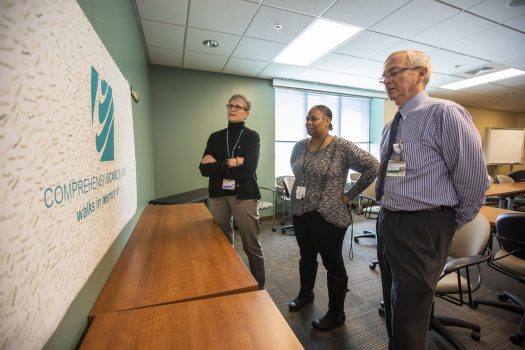
Bev Byram, VCCC office manager Quentella Carpenter and Stephen Raffanti with a memorial wall at the VCCC to patients who died — a reminder of the early days of HIV-AIDS when the disease was usually fatal. Photo by Anne Rayner
When Raffanti looks back, it’s as though he’s a soldier remembering a harrowing battle, in which there’s only time to focus on what needs to be done next, with no time to think about how terrible the situation is. He knows the number from memory: the first 12 months the VCCC was open, 359 of its patients died. Almost a death a day.
“It was one of those things that you only get through because you don’t really know you’re in it,” he said.
The VCCC staff came up with their own weekly ritual to honor and remember their patients.
“We had a staff meeting every Monday morning, and at the end of the meeting we would light a candle, turn out the lights in the conference room, and talk about the people who had died that week. We would read out the names and share thoughts and stories.”
“People went from death’s door to back to work,” Raffanti said. “At the beginning of 1996 we had 90 patients in hospice or being cared for by home health. At the end of 1996, we had three. People would run up and hug you because they were feeling so good.”
This many years later, Byram shakes her head at the memory of the hundreds of patients they cared for and lost.
“It sort of stripped away all the things that didn’t matter,” Byram said. “So we had real intense relationships with our folks.”
She held up a wrist. “A patient who died in about 1994 gave me this bracelet and asked me not to take it off until there’s a cure. I’ve worn it for however many years that is. A lot.”
The tide began to turn in 1996, when the first effective antiretroviral drugs for HIV became available. It was as though a sentry staring into unremitting night suddenly saw glimmers of dawn, and then full sunlight.
“People went from death’s door to back to work,” Raffanti said. “At the beginning of 1996 we had 90 patients in hospice or being cared for by home health. At the end of 1996, we had three. People would run up and hug you because they were feeling so good.”
Over the years the drugs have improved and have transformed being HIV-positive to a chronic illness that can be managed, rather than a death sentence. It has been a stunning transformation.
Katrina Robertson lived through that transformation. From her first visit to the VCCC in 1995, Bev Byram was her provider – although that word is inadequate for their relationship.
The clinical care offered includes specialists in pediatrics, psychiatry and obstetrics, as well as nurses, nurse practitioners, dietitians and case managers. “These are incredible people to work with, they are mission-driven,” Raffanti said.
“It was more than a doctor-patient relationship,” Robertson said. “She hung in there with me. She saw me on my deathbed, and now my viral load is undetectable. I have a 27-year-old daughter and she and Bev have been my biggest cheerleaders and supporters.”
Robertson struggled for years to overcome her addiction, to battle a TB infection, and to manage her HIV as well. She became involved with the Thistle Farms Residential Program, called Magdalene, which defines itself on its website as “a two-year residential community, offering women survivors of trafficking, prostitution, and addiction the time and space they need to heal.” Robertson is still involved with Thistle Farms, serving as the National Sales Director of their Body & Home social enterprise and is also a speaker and an advocate for people struggling to overcome the hurdles she herself has faced.
“It’s been an amazing journey,” she said of her life and where it has taken her.
Those are almost exactly the words Raffanti uses when describing the 25 years of the VCCC. The center now has satellite locations in Columbia, Cookeville and Springfield (all held in local health departments), and the VCCC’s current location in Vanderbilt Health at One Hundred Oaks is not only an attractive, state-of-the-art clinical facility but houses research and education components as well. National and international groups regularly visit in order to take its model back and apply it in their own clinics.
The clinical care offered includes specialists in pediatrics, psychiatry and obstetrics, as well as nurses, nurse practitioners, dietitians and case managers.
“These are incredible people to work with, they are mission-driven,” Raffanti said.
The work of the obstetrics staff draws special praise from Byram: “We have followed hundreds of moms who have delivered almost 500 babies, and only one of those hundreds of babies turned out to be HIV positive,” she noted with pride.
“We have more than 4,000 active patients,” Raffanti said. He added that his experience in his quarter century at the VCCC has confirmed the importance of health care that it rooted in the life experiences of patients. “Health goes way beyond a diagnosis and a prescription,” he said.
To observe and celebrate the VCCC and the impact it has had on its patients’ lives, an anniversary event is being planned for June 29. Details of the event will be announced later.
To view a National Institutes of Health video in which Bev Byram and Stephen Raffanti discuss their work at the VCCC, click here.




